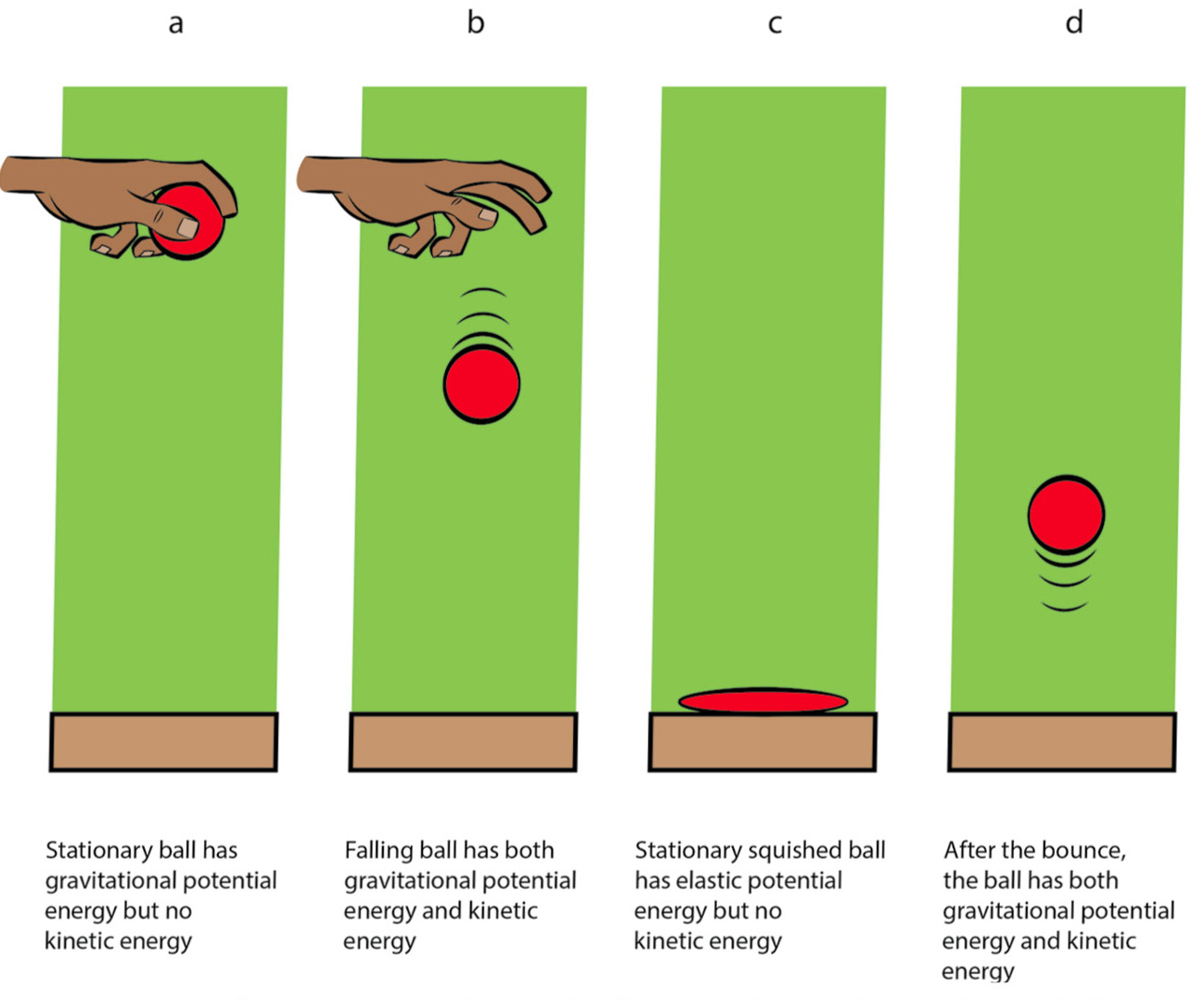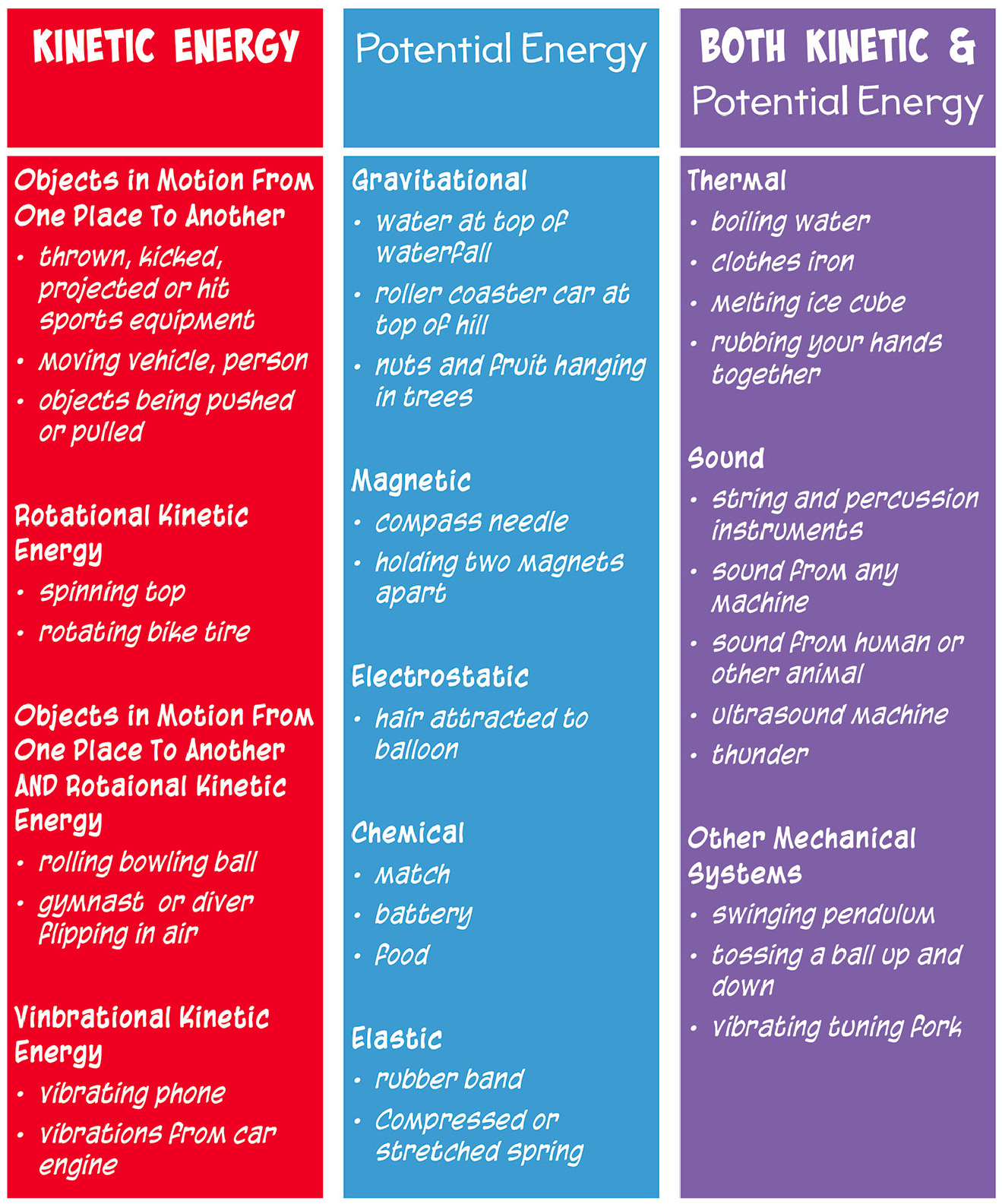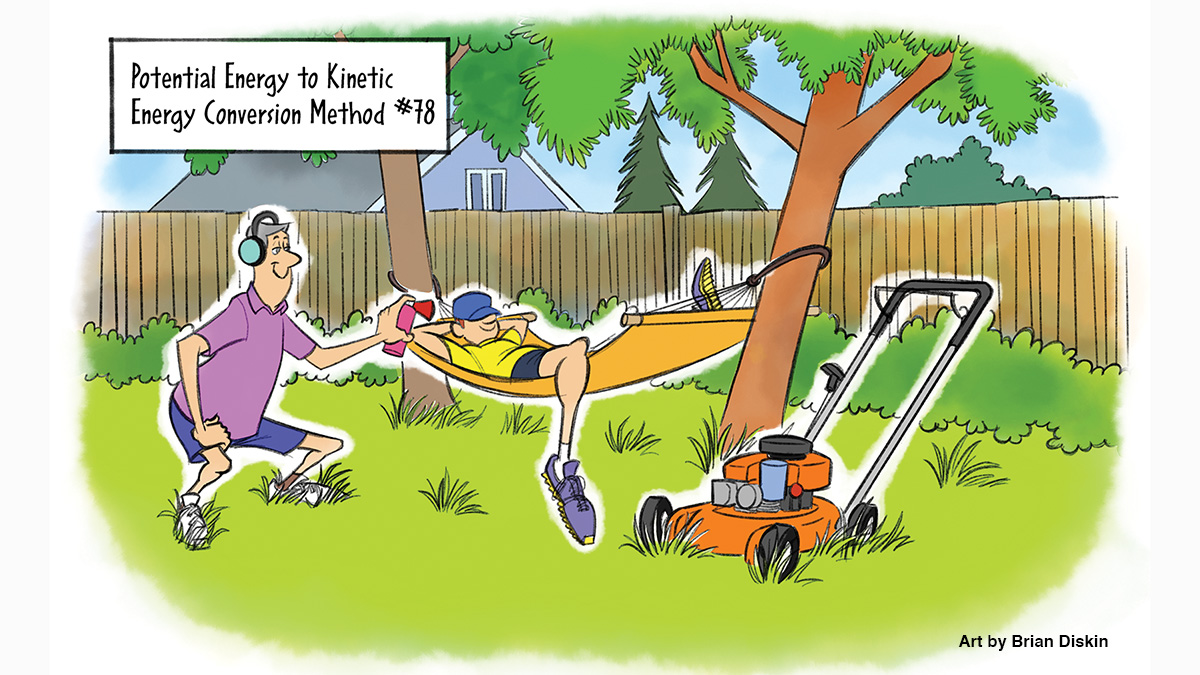Science 101
Q: What Is Energy?
A: You can probably guess that there’s not a simple answer to that question. A physicist might say that energy is the ability to do work, although that doesn’t tell us what energy really is. Is it a substance? (no) Is it real? (yes) And because it’s so hard to define, many teachers will instead just describe some of the characteristics. That’s very similar to how we discuss “life”—without actually defining it. Since there’s no universally agreed upon definition of life, we usually instead talk about the “characteristics of life,” living vs. nonliving things, and the different kinds of life. In the same way, rather than actually defining energy, teachers often talk about the characteristics of energy and different kinds of energy, although, as we’ll see, memorizing different types of energy isn’t what’s really important.
Energy is one of those scientific terms (like theory) that is commonly used outside of science and outside of the classroom with a variety of colloquial meanings. So this is another case where students don’t enter the classroom as blank slates but come with preconceptions about what energy means. It’s a good idea to first find out what your students already think energy is, and then later they can compare their original ideas with what we know about it from scientists.
What Energy Is Good For
Energy is needed to cause motion or to create change. Examples of using energy to make things move include riding your bicycle, kicking a ball, or launching a rocket. Examples of using energy to create a change include heating a pot of water, flattening out a ball of clay, melting an ice cube, or just keeping warm on a cold day.
I said that memorizing the different types of energy isn’t the most important thing. That’s why the Next Generation Science Standards (NGSS) doesn’t dwell on different types of energy (except for one place discussed below). Rather, in keeping with the three-dimensional learning approach, the emphasis is more on the (a) practices, i.e., how scientists would investigate energy and model it; (b) crosscutting concepts, of which energy is a big one; and (c) disciplinary core ideas, such as the fact that when objects collide, energy can be transferred from one object to another, thereby changing their motion.
An analogy to money will serve to illustrate the unimportance of “forms of energy.” Think about all the different ways or places that money could be stored. You might have some in your pocket or purse, in a savings account, hidden in your mattress, in coins or in bills, invested in stocks, etc. But when people talk about using money to make a purchase, you usually don’t hear them specifying the form or source of the money. The fact that the money for the purchase came out of a savings account vs. a piggy bank doesn’t matter. Money is money, no matter the source. What matters is what money is good for, how it is used, how it is transferred from one place to another. And it’s the same for energy! What matters is not the form of the energy but what energy is good for, how it is used, and how it is transferred from one place to another.
How energy is transferred from place to place is the one instance where NGSS mentions different types of energy: Energy can be transferred from place to place by sound, light, heat, and electric currents. Energy can also be transferred from place to place by objects in motion. But notice that it doesn’t refer to those as different forms of energy, just different ways that energy can move from one place to another.
When energy is used—to do work or to change something—its form or its source doesn’t matter as long as you have enough of it to accomplish your goal. Energy is present whenever there are moving objects, sound, light, heat, or electricity. In all those cases, energy is moving from one place to another.
Kinetic and Potential Energy
When an object is moving, like a baseball or a car, we say it has kinetic energy, i.e., energy of motion. Just how much kinetic energy the object has depends on its mass and its speed. For two objects with the same speed, the more massive object has more kinetic energy. So a car going 50 MPH has more energy than a baseball going 50 MPH. If two objects have the same mass, then the faster object has more kinetic energy.
Sometimes objects have potential energy. Potential energy occurs due to the position of an object or, more generally, from the arrangement of objects that are exerting a force on each other. One example is when you stretch a rubber band. While you’re holding it stretched, it has elastic potential energy. If you let go of it, it will start to move back to its previous shape. That’s what happens with potential energy: If something starts to move when you let go of it, then it is part of a system that has potential energy. (Here, a “system” refers to one or more interacting objects. The elastic molecules in a rubber band can be considered a system.)
Another example occurs when you pull back a ball on a string and let it go so it starts swinging. The fact that it started moving when you let go of it means that there’s a force on it and that it had potential energy. If you let the ball continue to swing (Figure 1), it has all its energy in the form of potential energy when it’s at the top of its swing, at which point it comes to a stop, and therefore has no kinetic energy. At the bottom of its swing, all of its energy is kinetic energy, with no potential energy. At intermediate positions, it has some kinetic energy and some potential energy. The total energy—potential plus kinetic—remains the same, and as it swings, the ball’s energy keeps changing from potential to kinetic to potential to kinetic, and so on. The fact that the total energy of the ball remains constant is one example of the conservation of energy.

Conservation of Energy
Conservation of energy is one of the most important principles in all of science. It means that energy cannot be created or destroyed; it can only change form. The expression “produce energy” really refers to the conversion of stored energy into a desired form for practical use. Here’s a kind of thinking game you can play with your students. Whenever you have some energy, you can always ask about where it came from. For example:
Q: Where did the energy come from for you to pull the ball up to start it swinging?
A: From the energy in my body, which includes chemical energy and electrical energy.
Q: Where did your body get that energy?
A: From the food I eat. My food contains chemical energy. Food provides humans and other animals with the materials they need for body repair and growth and the energy they need to maintain body warmth and for motion.
Q: Let’s say your food is a piece of chicken. Where did the energy in the chicken come from?
A: From the chemical energy in the food that the chicken ate. Perhaps it ate corn.
Q: Where did the energy in the corn come from?
A: From sunlight! Energy travels from the Sun to the Earth in the form of light, and when the corn was growing, it stored some of that solar energy (as chemical energy, thanks to photosynthesis).
So all the energy we get from the food we eat came from the Sun! Did you know that you are solar powered? The point of that game is that energy doesn’t get created out of nothing; it has to come from somewhere.
You can ask similar questions for where a car’s kinetic energy came from. Here’s another one: Describe the energy changes that occur when you drop a bouncy ball. Referring to Figure 2, before the ball is released, all its energy is gravitational potential energy. While it’s falling, it has both kinetic and potential energy. When it hits the floor, it gets squeezed, at which point all the energy is elastic potential energy (like a compressed spring). Then the ball springs back up (bounces), when that elastic potential energy gets converted to kinetic energy again. But as the ball rises and slows down, its kinetic energy is gradually converted to (gravitational) potential energy again.

Here’s another example of potential energy. Electrical potential energy is present when positive and negative electric charges are separated from each other, as in a battery. When you turn on a gadget that is battery-operated, such as a flashlight or a toy, the electrical potential energy stored in the battery is converted into other forms of energy such as sound, movement of an object, heat, and/or light.
Tricky Terminology
You might have heard potential energy referred to as “stored” energy, but two misconceptions may arise when referred to in this way. First, saying that energy is stored in something may imply that energy is some sort of invisible substance, which it isn’t. Second, consider a pencil held above a classroom floor. Many would say that the pencil has potential energy stored within it, and it is often convenient to think that only the pencil has potential energy. However, the pencil has potential energy only because it is near the Earth, and both the pencil and the Earth exert gravitational forces on each other. In other words, if you take away the Earth, the pencil would no longer have that potential energy. So it’s clear that that potential energy was not stored in the pencil. Rather, the potential energy was part of the “pencil–Earth system.”
Going back to our money analogy, imagine having a thousand dollars in the bank and never adding to it or spending any of it. But you can put some of it in a special account called “kinetic energy” (that’s related to movement) and you can put some of it in a different account called “potential energy” (related to potential movement). And you can keep moving the money around between these two accounts, but it will always add up to a thousand. Energy is like that: It is never created, never destroyed, only moved or converted to other forms.
Before I give you another game (which can also be used for formative assessment), I should distinguish between heat and thermal energy. If a pot on the stove is hot, it contains thermal energy, which is the random kinetic energy of the molecules in the pot. A thermometer measures thermal energy. Heat refers to energy moving from one object to another as a result of the temperature difference between the objects. Heat is thermal energy being transported from warmer objects to cooler objects. You’ll feel an example of heat if you touch that hot pot. The fast-moving molecules in the pot will slam into the molecules in your skin and make your skin molecules move much faster. Ouch! (Did you know that’s how you get burned when you touch something hot?)
Here’s another game: Name a gadget or a situation in which energy is converted in each of the following ways:
(a) from gravitational to kinetic;
(b) from kinetic to thermal;
(c) from electrical to thermal;
(d) from electrical to gravitational;
(e) from chemical to gravitational;
(f) from chemical to electrical;
(g) from kinetic to electrical;
(h) from light to electrical.
“Forms of Energy” are Misleading
I’ve seen some websites that try to classify all forms of energy as either kinetic or potential energy. There isn’t universal agreement about such classifications, and some forms of energy are not clearly one or the other; sound and thermal energy include both kinetic and potential energy (see Figure 3). And recall that the falling ball in Figure 2 had both kinetic and potential energy. Some websites put electricity under “kinetic energy,” with the idea being that electrical energy results from the kinetic energy of the electrons in the wire. That’s wrong, for several reasons that I’ll be happy to elaborate on if you ask me to. For now, I’ll just suggest that, while some types of energy are clearly kinetic and some types are clearly potential, it would be a mistake to shoehorn all types of energy into one of those two categories.

Misuse of the Word Energy
Even though some people use the word energy, the following terms are not forms of energy, have no scientific basis, and are considered pseudoscience, i.e., not real science:
- Free energy (meaning a perpetual motion machine)
- Cosmic energy
- Psychic energy
- Chi (or Qi) energy
- Chakra energy
- Orgone energy
- Energy medicine, energy therapy, energy healing, or energy psychology
- Crystal energy
- Life energy or vital energy
- Spiritual universal energy
Because of the abstract nature of energy, the term has been easily abused by promoters of mysticism and alternative therapies. We should be skeptical of claims of the existence of such non-scientific “energies” (see Online Resources).
Important Points About Energy
I haven’t mentioned every term you might have heard related to energy. As I said, the terminology isn’t what’s important, as the forms of energy are really quite arbitrary. If you have any way for energy to be acquired, moved, or from which work can be done, you have a kind of energy. What is important to know about energy includes:
- all matter contains it;
- we can store it in various forms—with chemicals, thermal energy, gravitationally, etc.;
- we can convert it from one form to another;
- we can use it to do things (i.e., to do work);
- we neither create nor destroy it;
- and we can generate, calculate, and measure its various forms.
The bottom line is that, while it’s difficult to define the term energy, it is a very useful concept, and it’s not difficult to identify, describe, and measure specific types of energy. People have learned how to change energy from one form to another so that we can do work more easily and live more comfortably.
Speaking of energy, a guy phoned and asked if I was interested in switching to an alternative energy supply... I said, “No, I think I’ll stick with food, thanks!”
Never stop learning. ●
Online Resources
Energy Medicine: https://en.wikipedia.org/wiki/Energy_medicine
Misuse of the word energy: http://skepdic.com/energy.html
Use and Misuse of the Concept of Energy: https://citeseerx.ist.psu.edu/viewdoc/download;jsessionid=220ABADBE4EFBB2F59DACC71EE8AF232?doi=10.1.1.669.3285&rep=rep1&type=pdf
Matt Bobrowsky is the lead author of the NSTA Press book series, Phenomenon-Based Learning: Using Physical Science Gadgets & Gizmos. You can let him know if there’s a science concept that you would like to hear more about. Contact him at: DrMatt@msb-science.com.
Physical Science Three-Dimensional Learning



